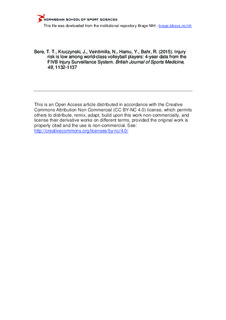| dc.contributor.author | Bere, Tone Tufte | |
| dc.contributor.author | Kruczynski, Jacek | |
| dc.contributor.author | Veintimilla, Nadege | |
| dc.contributor.author | Hamu, Yuichiro | |
| dc.contributor.author | Bahr, Roald | |
| dc.date.accessioned | 2015-10-27T10:19:15Z | |
| dc.date.available | 2015-10-27T10:19:15Z | |
| dc.date.issued | 2015-07-20 | |
| dc.identifier.citation | British Journal of Sports Medicine. 2015, 49, 1132-1137 | nb_NO |
| dc.identifier.uri | http://hdl.handle.net/11250/2358076 | |
| dc.description | This is an Open Access article distributed in accordance with the
Creative Commons Attribution Non Commercial (CC BY-NC 4.0) license, which
permits others to distribute, remix, adapt, build upon this work non-commercially,
and license their derivative works on different terms, provided the original work is
properly cited and the use is non-commercial. See: http://creativecommons.org/
licenses/by-nc/4.0/ | nb_NO |
| dc.description.abstract | Background: Little is known about the rate and pattern of injuries in international volleyball competition.
Objective: To describe the risk and pattern of injuries among world-class players based on data from the The International Volleyball Federation (FIVB) Injury Surveillance System (ISS) (junior and senior, male and female).
Methods: The FIVB ISS is based on prospective registration of injuries by team medical staff during all major FIVB tournaments (World Championships, World Cup, World Grand Prix, World League, Olympic Games). This paper is based on 4-year data (September 2010 to November 2014) obtained through the FIVB ISS during 32 major FIVB events (23 senior and 9 junior).
Results: The incidence of time-loss injuries during match play was 3.8/1000 player hours (95% CI 3.0 to 4.5); this was greater for senior players than for junior players (relative risk: 2.04, 1.29 to 3.21), while there was no difference between males and females (1.04, 0.70 to 1.55). Across all age and sex groups, the ankle was the most commonly injured body part (25.9%), followed by the knee (15.2%), fingers/thumb (10.7%) and lower back (8.9%). Injury incidence was greater for centre players and lower for liberos than for other player functions; injury patterns also differed between player functions.
Conclusions: Volleyball is a very safe sport, even at the highest levels of play. Preventive measures should focus on acute ankle and finger sprains, and overuse injuries in the knee, lower back and shoulder. | nb_NO |
| dc.language.iso | eng | nb_NO |
| dc.publisher | BMJ Publishing Group | nb_NO |
| dc.title | Injury risk is low among world-class volleyball players: 4-year data from the FIVB Injury Surveillance System | nb_NO |
| dc.type | Journal article | nb_NO |
| dc.type | Peer reviewed | nb_NO |
| dc.subject.nsi | VDP::Social science: 200::Social science in sports: 330::Other subjects within physical education: 339 | nb_NO |
| dc.source.journal | British Journal of Sports Medicine | nb_NO |
| dc.description.localcode | Seksjon for idrettsmedisinske fag / Department of Sports Medicine | nb_NO |
